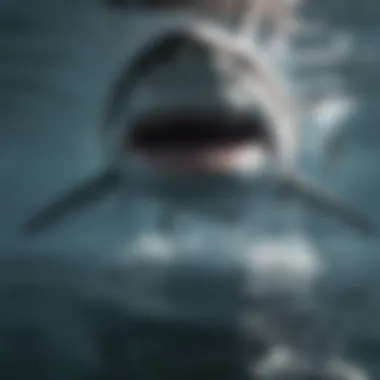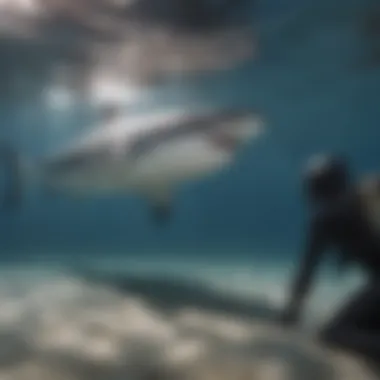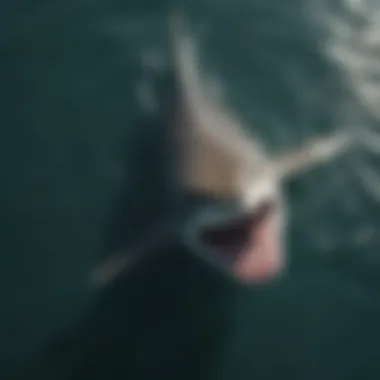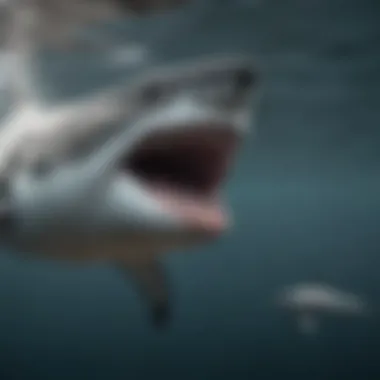Discovering Great White Sharks: Locations & Tips


Intro
Observing great white sharks in their natural habitat is an exhilarating experience for thrill-seekers and adventurers alike. These apex predators are not just fearsome but integral to marine ecosystems. Understanding where and how to see them enriches the experience, allowing for profound appreciation of their behavior and environmental role.
In this article, we will analyze the prime locations for shark sightings, explore effective techniques to increase the chances of a successful observation, and delve into the safety measures necessary for a rewarding and secure encounter. We also discuss the ethical considerations surrounding shark tourism, ensuring that experiences are not only thrilling but responsible as well.
To shape a comprehensive understanding of the topic, we will also look at gear recommendations, practical advice for aspiring observers, and the natural allure of interacting with such majestic creatures.
Join us as we navigate the waters where these magnificent hunters roam, and discover how to maximize your chances of encountering great white sharks without compromising safety or ethics.
Understanding Great White Sharks
The great white shark is one of the most captivating and formidable marine creatures. Understanding these sharks is crucial for several reasons. First, their biology provides insights into their hunting techniques and adaptations that have made them apex predators. Second, studying their behavioral patterns helps to mitigate risks associated with human-shark interactions. Lastly, recognizing their role in marine ecosystems highlights their importance in maintaining oceanic balance.
A comprehensive knowledge of great white sharks enhances the overall experience for thrill-seekers and extreme sports enthusiasts. It allows them to appreciate the magnificence of these creatures while ensuring safety during observation. The interplay between humans and great whites is delicate; understanding this relationship can lead to more responsible behavior in the water, minimizing disturbances to the sharks' natural habits.
Moreover, as awareness of ethical shark tourism increases, understanding great whites supports conservation efforts. A well-informed observer is often more respectful of marine ecosystems. This knowledge can lead to greater advocacy for sustainable practices and support for research programs aimed at protecting these unique animals.
"Knowledge is the first step towards responsible interaction."
Being aware of general shark biology, their behaviors, and ecological roles sets the stage for positive encounters. This piece will delve into these aspects, providing readers with a thorough overview of what makes great white sharks so essential to our oceans.
Top Destinations for Great White Shark Sightings
Observing great white sharks in their natural habitat is a thrilling endeavor for many adventure enthusiasts. The best locations for sightings provide not only the chance to see these majestic creatures but also an opportunity to learn about their behaviors and roles in marine ecosystems. These destinations allow visitors to engage directly with marine life while considering the safety and ethical implications of such encounters. Knowing where to look is crucial for maximizing the experience.
South Africa
Key locations in Gansbaai
Gansbaai, located on the southern coast of South Africa, is a premier destination for great white shark sightings. This town is renowned for its close proximity to Shark Alley, a channel rich in marine life. The presence of large populations of seals nearby significantly attracts great whites. The clear waters and relatively calm conditions also makes it a favored spot for shark cage diving. Such factors make Gansbaai popular among thrill-seekers and researchers alike, providing insight into the sharks in a responsible manner. The unique feature of this area is its seasonal peaks, where sightings can dramatically increase, presenting a chance to see these powerful predators up close.
Best time for sightings
The optimal time for sightings in Gansbaai is during the late winter to early spring months, specifically from May to September. During this period, the cooler water temperatures lure large shark populations closer to shore. This characteristic enhances the chances of sightings for those interested in shark tourism. However, visitors must be prepared for changing weather conditions which can occasionally hinder visibility. Therefore, planning visits around specific times can enhance the overall experience while ensuring safety and comfort.
Australia


Shark cage diving in Port Lincoln
Port Lincoln, South Australia, is recognized globally for shark cage diving experiences. This destination offers a rare opportunity to enter the ocean in a protective cage, allowing for encounters with great white sharks in their natural environment. The region provides clear waters, which are ideal for viewing these apex predators up close. Additionally, structured tours often ensure safety and adherence to environmental standards, making it a responsible choice for adventure tourism. Divers can witness the sharks' hunting techniques and learn about their ecology firsthand. However, participants should also prepare for the cold waters and be aware of the stresses that this activity can impose on marine life.
Observation off the coast of Queensland
Observing great whites off the coast of Queensland is another popular alternative. This region is less known than Port Lincoln but offers a unique experience with its more dynamic marine ecosystems. The advantage of this location is the beautiful beaches and broader array of marine life. This ecological diversity can enrich the experience for those lucky enough to spot a great white while participating in dolphin or whale watching tours. However, the chances of seeing great white sharks here can be unpredictable compared to South Australia.
California, USA
Famous shark locations
California boasts numerous famous locations for seeing great white sharks, particularly around the Farallon Islands and Monterey Bay. These regions are significant due to their abundant marine life and unique underwater landscapes. Here, the presence of large fish populations, seals, and sea lions creates a perfect hunting ground for the great whites. Adventurers often take tours that include knowledgeable guides who explain the behaviors and roles of these sharks. However, the offshore conditions can be challenging, and individuals should consider their comfort level before embarking on such experiences.
Recommendations for safe observation
When planning an observation trip in California, safety is key. It's essential to choose reputable tour operators, as they are knowledgeable about local regulations and shark behaviors. Always adhere to safety guidelines provided by the crew, which often includes not swimming alone and remaining calm if a shark approaches. Also, consider observing from a distance, particularly from boats or platforms, for those who prefer a less intense experience.
The Farallon Islands
The Farallon Islands, located off the coast of California, serve as another spectacular location for observing great white sharks. This marine sanctuary is home to diverse wildlife, including seabirds and marine mammals, which in turn attract sharks. Visitors can participate in boat tours that allow observation from safe distances, making it an appealing option for eco-tourism. The unique location is also integral to research efforts focused on shark populations and behavior. However, the remote nature of the islands means visitors should plan logistics carefully, especially regarding seasonal accessibility.
Methods of Observation
Understanding the methods of observation is crucial for anyone wanting to experience a great white shark encounter. These techniques enable individuals to observe these apex predators with a level of safety and respect for their natural behavior. Different approaches cater to varying thrill-seeking levels and personal preferences. Moreover, each method offers distinct experiences, benefits, and also requires specific considerations for both safety and ethical tourism practices.
Shark Cage Diving
Shark cage diving is a popular method for observing great white sharks up close. This technique allows divers to safely enter the ocean, secured within a cage, and be submerged while sharks are lured to the area. The cage protects you from potential harm while still providing an adrenaline-rich experience.
Overall, it offers a unique opportunity to observe the shark’s behavior in-depth. Locations like Gansbaai in South Africa or Port Lincoln in Australia are well-known for organized shark cage diving operations. These experiences often include a guided tour with marine biologists, providing insights into the species' behaviors and role in the ecosystem.
It is important to choose a reputable company for these dives. Not all operators follow the same safety protocols. In addition, understanding the environment beforehand helps with underwater visibility and enhances the encounter.
Surface Viewing
Surface viewing is another popular way to spot great white sharks without the need for getting wet. This method usually involves boats that take enthusiastic shark watchers out to known shark hotspots. Observers remain above the water while scanning for sharks swimming below or breaching the surface.
This method is suitable for those who prefer a less intense experience while still appreciating the majesty of great whites. It allows for photography opportunities without the challenges presented by underwater visibility. Particularly in areas like California, operators often provide commentary, explaining shark behavior and their habits. Tips for surface viewing include knowing the best times of day when shark activity peaks and understanding the indicators that suggest their presence.


Research and Conservation Programs
Engaging with research and conservation programs presents a more educational method of observing great whites. Many programs offer guided tours that integrate data collection and marine biology studies, giving participants insight into shark conservation efforts.
This approach not only provides observers with a chance to see great whites but also fosters a deeper understanding of their role in the marine ecosystem. Participating in these programs can contribute to ongoing research initiatives, helping to protect great white populations. Organizations such as Ocearch conduct tagging studies that allow public observation, tracking the migration patterns and behavior of sharks over time.
These experiences typically emphasize the importance of conservation in addressing the challenges that sharks face, from hunting to habitat loss. Joining a program can lead to profound learning moments about respecting marine life and promoting sustainable practices.
Safety Considerations
In the context of observing great white sharks, safety considerations are paramount. Engaging with these apex predators comes with inherent risks. Understanding these risks and taking the necessary precautions ensures the safety of both the observer and the sharks themselves. By adhering to guidelines and recommendations, thrill-seekers can enjoy a rewarding experience without jeopardizing personal safety or the delicate marine ecosystem. Failing to observe safety measures can lead to potentially dangerous situations, not only for individuals but also for these important species.
Precautions Before Observing
Before embarking on an adventure to see great white sharks, several essential precautionary measures should be taken. First, it is crucial to conduct thorough research on the specific location where the observation will take place. This includes understanding the seasonal behaviors of sharks and the best times for sightings. Conditions such as water temperature and visibility also affect safety and viewing opportunities.
Moreover, always choose reputable operators for shark cage diving or surface viewing. These companies should prioritize safety and conservation, ensuring that the equipment is properly maintained and that trained staff are available. Following any specific instructions provided by the crew is equally important, as they are skilled in managing potential encounters with sharks.
Additional Precautions Include:
- Wearing appropriate safety gear, such as wetsuits and life jackets.
- Avoiding the consumption of alcohol before or during the observation trip.
- Making sure to listen to safety briefings.
- Informing someone not participating about your plans.
Behavior While in Water
Understanding proper behavior while in the water can significantly enhance safety when observing great white sharks. First and foremost, remain calm and composed. Any sudden movements or erratic behavior can provoke curiosity in sharks, heightening the risk of an incident. Encounters should be treated with respect; remember that you are in their habitat.
It is also advisable to maintain a safe distance from sharks whenever possible. If underwater, try to keep your body in a vertical position and avoid flailing or splashing. The more still you are, the less you will attract unwanted attention.
Key Behavioral Tips:
- Focus on keeping a non-threatening posture while in the water.
- Avoid direct eye contact; instead, watch the sharks out of your peripheral vision.
- If a shark approaches, remain still until it moves away.
Guidelines from Experts
Experts consistently emphasize the importance of adhering to established guidelines to ensure a safe experience. These guidelines are often created based on shark behavior studies and years of experience with shark encounters.
“Respect the shark’s space. Disturbing their environment poses risks,” states marine biologist Dr. Sarah Blackwood, who has spent over a decade studying shark behaviors. Such insights reinforce the necessity of maintaining a safe and respectful distance.


Many organizations offer certification for shark observers. These programs educate participants about correct techniques and necessary knowledge before getting in the water. Engaging in these educational opportunities can be a wise step for those serious about shark observation.
Expert Recommendations Include:
- Always follow the directions given by trained professionals.
- Familiarize yourself with the local regulations regarding shark tourism.
- Stay informed about recent shark sightings and incidents in your selected observation area.
Taking these safety considerations seriously can transform your encounter with great white sharks into a memorable and enlightening experience. This fosters not only personal safety but also contributes to sustainable practices in marine tourism.
Ethical Considerations in Shark Tourism
Ethical considerations in shark tourism are crucial when discussing great white sharks. These apex predators, vital to marine ecosystems, face numerous threats due to human activities. As thrill-seekers come to observe these magnificent creatures, ethical tourism practices become more important. Responsible engagement ensures the long-term survival of shark populations while allowing enthusiasts to witness their majesty.
Impact of Shark Tourism on Populations
Shark tourism can have both positive and negative impacts on great white populations. On one hand, well-managed tourism can contribute to conservation efforts by raising awareness. Tourists often fund local initiatives, which help protect habitats and establish marine reserves. However, unmanaged tourism may disturb shark behavior, lead to overfishing, and encourage illegal practices like finning.
Understanding how these factors intertwine is essential. For instance, in regions where sharks are heavily trafficked for tourism, excessive interaction can lead to stress in these animals. This can alter their natural feeding and breeding patterns, which has long-term consequences for populations. Ethical tourism organizations advocate for sustainable practices that minimize these harmful effects.
Responsible Viewing Practices
Engaging in responsible viewing practices is key for anyone interested in shark tourism. Tour operators play a vital role in educating visitors about the delicate balance of marine ecosystems and demonstrating best practices. Several guidelines can enhance safety and reduce impact:
- Choose Certified Operators: Always opt for tour operators with certifications in ethical practices.
- Maintain Distance: Observe sharks from a safe distance to avoid disturbing their natural behavior.
- Limit Interactions: Engage in activities that limit direct interaction, like surface viewing instead of cage diving.
By following these guidelines, enthusiasts contribute effectively to conservation. Educating others about responsible practices further amplifies the positive effects of shark tourism.
Support for Conservation Efforts
Supporting conservation efforts is a critical aspect of ethical shark tourism. Tourists can participate in initiatives that prioritize the well-being of great whites. Several avenues for support exist:
- Contribute to Research Projects: Many organizations offer opportunities to become involved in shark research. This participation can range from funding to citizen science initiatives.
- Advocate for Marine Protected Areas: Supporting policies that establish marine reserves plays a significant role in shark conservation. Strong regulations can help protect essential habitats.
- Educate Others: Sharing knowledge about sharks’ ecological roles and the importance of conservation can inspire action within communities.
Conservation thrives when individuals recognize the intrinsic value of great white sharks beyond just tourism. By becoming advocates, tourists foster a protective environment for these creatures.
The End
The conclusion serves as an essential component of this article about great white sharks. It distills the key insights and observations presented throughout the text, guiding readers to a deeper understanding of these magnificent creatures and the responsible ways to observe them.
In summary, great white sharks are not just apex predators; they are crucial players in their ecosystems. Recognizing the environments where they can be seen enriches the experience for thrill-seekers and adventure lovers. Readers gain valuable knowledge about acceptable practices that protect both the sharks and their habitats while indulging their sense of adventure.
Summarizing Insights on Great White Sharks
Great white sharks are fascinating creatures that capture the imaginings of many. Their remarkable biology, instinctual behaviors, and critical role in the marine ecosystem deserve our exploration. This article has navigated various means of observing these majestic fish, highlighting the prime destinations across the globe. From Shark Cage Diving in Port Lincoln, Australia, to surface viewing in California, possibilities abound for those eager to see great whites in nature.
Moreover, ethical considerations have emerged as a central theme in shark tourism. As excitement for shark sightings rises, understanding the impact of tourism and maintaining responsible observation practices becomes imperative. Supporting conservation efforts is essential not only to keep these animals safe but also to ensure that the ecosystems they inhabit thrive without the pressures of unsustainable tourism.







